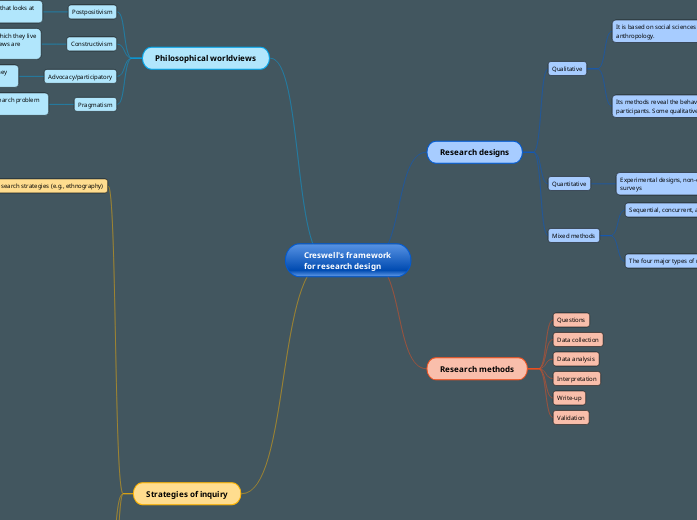Creswell's framework for research design
Research designs
Qualitative
It is based on social sciences like psychology, sociology, and anthropology.
Its methods reveal the behavior and perspective of study participants. Some qualitative research methods are:
One-on-one interview
Focus groups
Ethnographic research
Case study research
Record keeping
Observation
Quantitative
Experimental designs, non-experimental designs, such as surveys
Mixed methods
Sequential, concurrent, and transformative
The four major types of mixed methods designs are:
The Triangulation Design
The Embedded Design
The Explanatory Design
The Exploratory Design
Research methods
Questions
Data collection
Data analysis
Interpretation
Write-up
Validation
Philosophical worldviews
Postpositivism
It is a deterministic and reductionistic philosophy that looks at the causes of an objective "real-world" outcome.
Constructivism
Researchers seek understanding of the world in which they live and work. It is subjective and thus, participants' views are studied.
Advocacy/participatory
This research worldview deals with policies and the way they affect participants.
Pragmatism
It aims at analyzing and understanding the research problem through multiple methods.
Strategies of inquiry
Qualitative research strategies (e.g., ethnography)
Grounded theory
Phenomenological research
Narrative research
Quantitative research strategies (e.g., experiments)
Primary quantitative research methods
Techniques and types of studies
Survey research
Cross-sectional surveys
Longitudinal surveys
Correlational research
Causal-comparative research
Experimental research
Data collection methodologies
Sampling methods
Probability sampling
Simple random sampling
Stratified random sampling
Cluster sampling
Systematic sampling
Non-probability sampling
Convenience sampling
Consecutive sampling
Quota sampling
Snowball sampling
Judgmental sampling
Using surveys and polls
Data analysis techniques
Strengths, Weakness, Opportunities, and Threat (SWOT) analysis (a type of statistical analysis technique used by organizations)
Conjoint analysis (market analysis method)
Cross-tabulation (preliminary statistical market analysis method which establishes relationships, patterns, and trends within the various parameters of the research study)
Secondary quantitative research methods
Data available on the internet
Government and non-government sources
Public libraries
Educational institutions
Commercial information sources
Mixed methods strategies (e.g., sequential)
Sequential mixed methods
The researcher seeks to elaborate/expand on the findings of one method with another method.
Concurrent mixed methods
The researcher converges/merges quantitative and qualitative data in order to provide a comprehensive analysis of the research problem.
Transformative mixed methods
The researcher uses a theoretical lens as an overarching perspective within a design that contains both quantitative and qualitative data.
